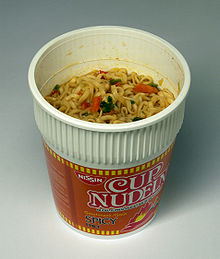Cup noodle
 A container of Cup Noodles | |
| Alternative names | Cup Noodles |
|---|---|
| Type | Instant noodles |
| Place of origin | Japan |
| Region or state | Tokyo |
| Created by | Momofuku Ando |
| Invented | 1971 |
| Other information | "Cup Noodle" and "Cup Noodles" are Registered Trademarks of Nissin Foods[1] |
Cup noodle is a registered trademark of Nissin Foods[1] and is known as precooked Instant noodles with flavoring powder and/or seasoning sauce sold in a polystyrene, polyethylene, or paper cup.[2][3][4][5][6] The flavoring can be in a separate packet or loose in the cup. Hot water is the only ingredient that is needed separately. Cooking takes 3–5 minutes. Now, many kinds of precooked instant noodle have been consumed around the world, as a popular staple.
History
In 1971, Japanese food company Nissin Foods introduced Nissin Cup Noodles,[7] a cup noodle to which boiling water is added to cook the noodles. A further innovation added dried vegetables to the cup, creating a complete instant soup dish. Both Cup Noodle and Cup Noodles are registered trademarks of Nissin Foods.[1]
Precooked instant noodles sold in a cup by country
South Korea

Keop-ramyeon is famous in South Korea. Popular instant noodles include Nongshim's Bowl Noodle Soup, Shin Cup Noodle Soup and Samyang's Hot Chicken Flavor Ramen.[8] South Korea has the largest quantity of consumption of instant noodle or precooked instant noodle's country per year.[9] Based on market research, males consume more precooked instant noodle than females in South Korea. It is the second largest food type after steamed rice that contributes to the overall energy intake of individuals in South Korea.[10] Furthermore, the younger generation (20 to 49 years old) are more likely to consume them and the demographic of consuming bowl-type noodles are the middle class or high class.
Mexico
Precooked instant noodle was introduced in 1990 by Maruchan. Due to its popularity, instant noodles are often referred to simply as "Maruchan". Today, many local brands such as "La Moderna" and "Herdez" have developed their own instant noodles, along Nissin, which is also a newcomer.
Philippines
Brands available in the Philippines include Lucky Me, Payless, Nissin (unrelated to Japan's Nissin Foods), QuickChow, Maggi and Ho-Mi. They are sold in packets, sealed paper cups, or sealed foam food containers.
Sweden
Precooked instant noodles are usually sold for 10 SEK per package.
United Kingdom

A common form of instant noodles in Britain is Pot Noodle, a cup noodle first marketed by Golden Wonder in 1977, and acquired by Unilever in 1995. These use artificial flavorings and are generally suitable for vegetarians (there is no chicken in "Chicken and mushroom flavour" Pot Noodles, for example) and are sold by virtually every major supermarket chain, general groceries shops, and convenience stores. Boiling water is added to the noodles to cook them.
United States
In 1972, Nissin Foods introduced "Nissin Cup Noodles" in a foam food cup, which led to an upsurge in popularity. Soon after, many other competing companies were offering similar instant noodle products.
See also
References
- ^ a b c Cup Noodle(登録1183902)and Cup Noodles(登録2681210) [1] Archived 2021-03-01 at the Wayback Machine
- ^ Gulia, Neelam; Dhaka, Vandana; Khatkar, B. S. (2014-01-01). "Instant Noodles: Processing, Quality, and Nutritional Aspects". Critical Reviews in Food Science and Nutrition. 54 (10): 1386–1399. doi:10.1080/10408398.2011.638227. ISSN 1040-8398. PMID 24564594. S2CID 20751842.
- ^ Lee, Hai woon (27 June 2013). "Korean Cup Noodles Served on American Airlines". The Chosun Ilbo. Archived from the original on 5 March 2021. Retrieved 23 April 2017.
- ^ Kajimoto, Tetsushi; White, Stanley (17 May 2016). "Sucked into deflation again - Japan's $2 cup noodle binge is sign of the times". Reuters. Archived from the original on 8 October 2022. Retrieved 23 April 2017.
- ^ Arguillas, Carolyn O. (15 April 2017). "Wao parish priest appeals for tents, water for quake-affected residents". MindaNews. Archived from the original on 25 February 2021. Retrieved 23 April 2017.
- ^ Chan, Samuel (23 April 2017). "Wait for share prices to be right, then buy and hold". The Straits Times. Archived from the original on 6 March 2021. Retrieved 23 April 2017.
- ^ "Nissin Foods Official site". Archived from the original on 2022-05-21. Retrieved 2022-05-22.
- ^ 김, 지윤 (30 May 2017). "육개장 사발면의 포효… "컵라면 王, 바로 접니다"". Herald Business (in Korean). Archived from the original on 28 July 2017. Retrieved 27 July 2017.
- ^ Chung, Chin-Eun; Lee, Kyung-Won; Cho, Mi-Sook (2010). "Effect of Ramyen and Noodles Intake in Diet & Health Status of Koreans". Journal of the Korean Society of Food Culture. 25 (2): 109–116. ISSN 1225-7060. Archived from the original on 2023-10-18. Retrieved 2020-09-30.
- ^ Park, Juyeon; Lee, Jung-Sug; Jang, Young Ai; Chung, Hae Rang; Kim, Jeongseon (2011). "A comparison of food and nutrient intake between instant noodle consumers and non-instant noodle consumers in Korean adults". Nutrition Research and Practice. 5 (5): 443–9. doi:10.4162/nrp.2011.5.5.443. ISSN 1976-1457. PMC 3221830. PMID 22125682.
9.[1]
- ^ Gulia, Neelam; Dhaka, Vandana; Khatkar, B. S. (2014-01-01). "Instant Noodles: Processing, Quality, and Nutritional Aspects". Critical Reviews in Food Science and Nutrition. 54 (10): 1386–1399. doi:10.1080/10408398.2011.638227. ISSN 1040-8398. PMID 24564594. S2CID 20751842.
